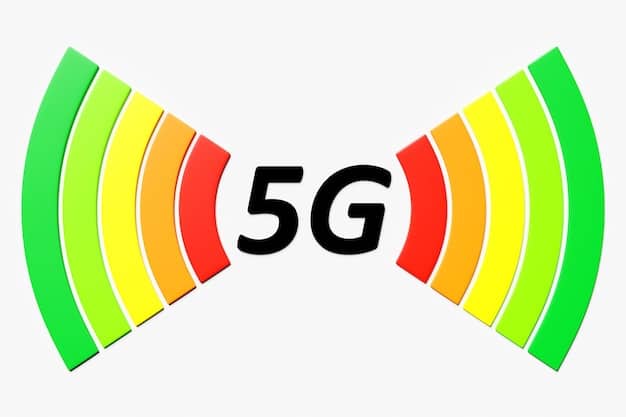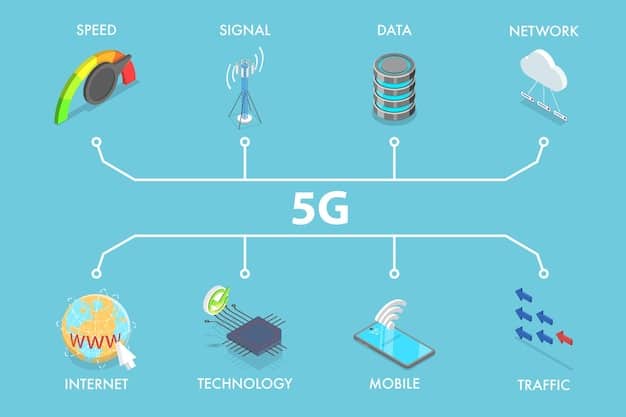Wi-Fi 6E vs. Wi-Fi 7: Real-World Performance in 2025

In 2025, the real-world performance difference between Wi-Fi 6E and Wi-Fi 7 routers will largely depend on device support, network congestion, and specific use cases, with Wi-Fi 7 offering potential improvements in speed and latency under optimal conditions.
The landscape of wireless connectivity is constantly evolving, and as we approach 2025, understanding the practical differences between Wi-Fi 6E and Wi-Fi 7 routers becomes crucial for making informed decisions about your network infrastructure.
Understanding Wi-Fi 6E and Wi-Fi 7: A Brief Overview
Before diving into the performance differences, it’s essential to understand what each standard offers. Wi-Fi 6E is an extension of Wi-Fi 6, utilizing the 6 GHz band for less congested and faster connections. Wi-Fi 7, on the other hand, is the next generation of Wi-Fi, promising even higher speeds, lower latency, and greater capacity.
Let’s break down their core features.
Key Features of Wi-Fi 6E
- 6 GHz Band: Provides more channels and less interference.
- OFDMA: Improves efficiency by allowing multiple users to share a channel simultaneously.
- MU-MIMO: Enables routers to communicate with multiple devices at once.
Key Features of Wi-Fi 7
- 320 MHz Channels: Doubling the channel width of Wi-Fi 6E for faster speeds.
- 4096-QAM: Increases data density for higher throughput.
- Multi-Link Operation (MLO): Allows devices to use multiple bands simultaneously for improved reliability and speed.
Wi-Fi 7 builds upon the foundation laid by Wi-Fi 6E, offering significant advancements in wireless technology. However, the real-world impact depends greatly on several factors that will be explored further.

Theoretical vs. Real-World Speed and Latency
Theoretical maximum speeds often overshadow practical performance. Wi-Fi 7 boasts impressive theoretical speeds, but several factors limit the speeds that can be achieved in real-world scenarios.
Let’s compare the theoretical and real-world speeds.
Theoretical Maximum Speeds
- Wi-Fi 6E: Up to 9.6 Gbps
- Wi-Fi 7: Up to 46 Gbps
These numbers are achieved under perfect conditions, which are rarely found in typical home or office environments. Factors such as distance, obstacles, and interference all affect real-world performance.
Real-World Speed Expectations in 2025
By 2025, it is likely that Wi-Fi 6E will have matured, and users can expect to consistently see:
- Wi-Fi 6E: Speeds of 1-2 Gbps in close proximity to the router, with decreasing speeds as distance increases.
For Wi-Fi 7, expectations could be:
- Wi-Fi 7: Speeds of 2-4 Gbps under ideal conditions, but this will be heavily dependent on device support and network conditions.
Latency, the delay in data transfer, is another crucial factor. Wi-Fi 7 aims to reduce latency significantly, through technologies like MLO, which could make a noticeable difference in applications such as online gaming and AR/VR.
Achieving these speeds requires compatible devices, a clear signal path, and minimal interference. Only then can users expect to see the performance gains promised by Wi-Fi 7.
Device Compatibility and Adoption Rates
The adoption rate of Wi-Fi 7 will play a significant role in determining its real-world performance difference compared to Wi-Fi 6E in 2025. If compatible devices are scarce, the benefits of Wi-Fi 7 will be limited.
Here’s how device compatibility will impact performance.
Early Adoption Challenges
Historically, new Wi-Fi standards take time to proliferate. In 2025, it’s reasonable to expect:
- Wi-Fi 6E: Widespread support across smartphones, laptops, and other devices.
- Wi-Fi 7: Limited support, primarily in high-end devices and new releases.
Impact on Network Performance
Even with a Wi-Fi 7 router, if most of your devices are Wi-Fi 6E or older, the network will operate at the speed of the slowest device. This is a crucial point to consider when evaluating the upgrade.
Future Outlook
As more devices adopt Wi-Fi 7, the performance benefits will become more pronounced. However, in 2025, Wi-Fi 6E will still be a relevant and capable standard due to its mature ecosystem and broad device support.
Device compatibility is a significant factor. Understanding the capabilities of the devices on your network is essential for making an informed decision about upgrading to Wi-Fi 7.
The Impact of Network Congestion and Interference
Network congestion and interference are two of the biggest enemies of wireless performance. Even the most advanced router can struggle in a crowded environment. Wi-Fi 6E and Wi-Fi 7 address these issues in different ways.
How do they mitigate network congestion and interference?
Wi-Fi 6E and the 6 GHz Band
Wi-Fi 6E leverages the 6 GHz band, which is less congested than the 2.4 GHz and 5 GHz bands used by older Wi-Fi standards. This can lead to a significant improvement in performance, especially in densely populated areas.
Wi-Fi 7 and Advanced Technologies
Wi-Fi 7 takes congestion management a step further with technologies such as:
- Multi-Link Operation (MLO): Allows devices to switch between bands to avoid interference.
- Preamble Puncturing: Enables the use of parts of a channel that are not affected by interference.
Real-World Scenarios
In a busy apartment building, Wi-Fi 6E can offer a noticeable improvement over older standards. Wi-Fi 7, with its advanced congestion management, could provide even better performance in such environments.

Congestion and interference can significantly impact wireless performance. Wi-Fi 7’s advanced features aim to mitigate these issues, potentially offering a more reliable and faster connection in crowded environments.
Use Cases: Where Wi-Fi 7 Shines
The performance benefits of Wi-Fi 7 will be most apparent in specific use cases that demand high bandwidth and low latency. While everyday tasks may not see a dramatic improvement, certain applications will benefit significantly.
Let’s explore some key use cases.
Gaming and AR/VR
Online gaming and augmented/virtual reality applications require low latency and high bandwidth to provide a seamless experience. Wi-Fi 7’s MLO and reduced latency could make a significant difference in these areas.
High-Definition Video Streaming
Streaming 4K or 8K video requires a stable and fast connection. Wi-Fi 7’s increased throughput can ensure smooth streaming, especially on multiple devices simultaneously.
Large File Transfers
Professionals who regularly transfer large files, such as video editors or graphic designers, will appreciate Wi-Fi 7’s faster speeds. This can significantly reduce transfer times and improve workflow efficiency.
Smart Home Devices
With the increasing number of smart home devices, a robust and reliable network is essential. Wi-Fi 7’s improved capacity can handle a large number of connected devices without compromising performance.
Wi-Fi 7’s performance benefits will be most noticeable in bandwidth-intensive and latency-sensitive applications. While everyday tasks may see incremental improvements, these use cases will truly showcase its capabilities.
Cost Analysis: Wi-Fi 6E vs. Wi-Fi 7 Routers in 2025
Cost is always a factor when considering a technology upgrade. Early adopters often pay a premium for the latest technology, and Wi-Fi 7 is no exception. By 2025, the cost difference between Wi-Fi 6E and Wi-Fi 7 routers will likely be a key consideration for many consumers.
Here’s a breakdown of the cost factors.
Initial Investment
In 2025, it is reasonable to expect:
- Wi-Fi 6E Routers: Prices will have stabilized, with a wide range of affordable options available.
- Wi-Fi 7 Routers: Will likely be more expensive, targeting the high-end market and early adopters.
Long-Term Value
While Wi-Fi 7 routers may have a higher upfront cost, they could offer better long-term value if you plan to upgrade your devices to Wi-Fi 7 compatible models in the future.
Total Cost of Ownership
Consider the total cost of ownership, including the cost of the router, compatible devices, and any necessary network upgrades. This will provide a more accurate picture of the overall investment.
Cost considerations are crucial when evaluating a technology upgrade. Weigh the upfront cost against the potential long-term benefits and consider the overall impact on your network infrastructure.
| Key Aspect | Brief Description |
|---|---|
| 🚀 Speed Potential | Wi-Fi 7 offers significantly higher theoretical speeds than Wi-Fi 6E. |
| 📱 Device Compatibility | Wi-Fi 6E will likely have broader device support by 2025. |
| 📶 Congestion Handling | Wi-Fi 7 boasts advanced technologies to handle network congestion. |
| 💰 Cost Factor | Wi-Fi 6E routers will likely be more affordable in 2025. |
Frequently Asked Questions
▼
Wi-Fi 7 has the potential to increase your internet speed. However, the actual speed increase would depend on your internet service provider, the capabilities of the router, and network congestion.
▼
It depends on your needs. If you have many Wi-Fi 7-compatible devices and require high bandwidth and low latency, then upgrading to Wi-Fi 7 might be worth considering. Otherwise, keeping Wi-Fi 6E could be reasonable.
▼
The main advantages of Wi-Fi 7 are higher bandwidth (up to 320 MHz channels), increased data density (4096-QAM), and multi-link operation (MLO), making it faster and more efficient than Wi-Fi 6E.
▼
Yes, both the router and the devices you want to connect need to be Wi-Fi 7 compatible. Older devices won’t be able to take advantage of the new technology, and you won’t get the expected performance.
▼
No, Wi-Fi 6E will remain a relevant and capable standard for many years. It offers significant improvements over older Wi-Fi versions and has broad device support. It’s also cheaper than Wi-Fi 7.
Conclusion
Assessing the real-world performance difference between Wi-Fi 6E and Wi-Fi 7 routers in 2025 requires considering factors such as theoretical vs. actual speeds, device compatibility, network conditions, use cases, and cost. While Wi-Fi 7 promises significant advancements, widespread adoption and tangible benefits will depend on the maturation of the technology and the availability of compatible devices, making Wi-Fi 6E a practical and potent choice for many users.





